Control a 3-wire continuous 360-degree servo in ARC: adjustable forward/reverse speeds, start/stop buttons, board/port selection and test controls
How to add the Continuous Servo robot skill
- Load the most recent release of ARC (Get ARC).
- Press the Project tab from the top menu bar in ARC.
- Press Add Robot Skill from the button ribbon bar in ARC.
- Choose the Servo category tab.
- Press the Continuous Servo icon to add the robot skill to your project.
Don't have a robot yet?
Follow the Getting Started Guide to build a robot and use the Continuous Servo robot skill.
How to use the Continuous Servo robot skill
Unlike a Standard Servo, a continuous servo has its internals changed to allow continuous 360° rotation. The two parts that are removed from a standard servo to create a continuous rotation servo are:- Mechanical Stop: The spindle will stop if you attempt to rotate a standard servo further than 180 degrees. That is due to a mechanical stop built onto the output gear within the servo. Continuous servos have that stop removed.
- Potentiometer: The potentiometer in a standard servo records the position of the output gear. A potentiometer can only rotate to the physical limits of the internal wiper. When the potentiometer is removed (or replaced with resistors), the circuit does not know its position, and therefore, the ability to specify positions is gone.
Due to the variety of servo attachments, continuous servos make great movement motors for wheels and tractor treads. Rather than using a standard DC Gear Motor, a continuous servo provides you with greater speed rotation accuracy.
This servo skill lets you click the forward and reverse buttons to activate a continuous servo. The continuous servo will only move at the speed you specify in the skill's settings (forward and reverse values). The values are set to 180 forward and one reverse by default.
*Note: Like all robot skills, this does not save the last servo position used. To set a servo position when the robot connects, create an initialization script using the Connection Skill.
Main Window
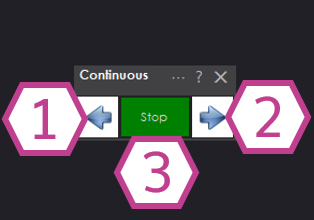
1. Forward Button
The servo will start spinning in the forward direction (depending on orientation).
2. Stop Button
Pressing the Stop button will release the servo and slow to a stop. If the gearing allows, you should now be able to move the output gear by hand.
3. Reverse Button
The servo will spin in the reverse direction (depending on orientation).
Settings
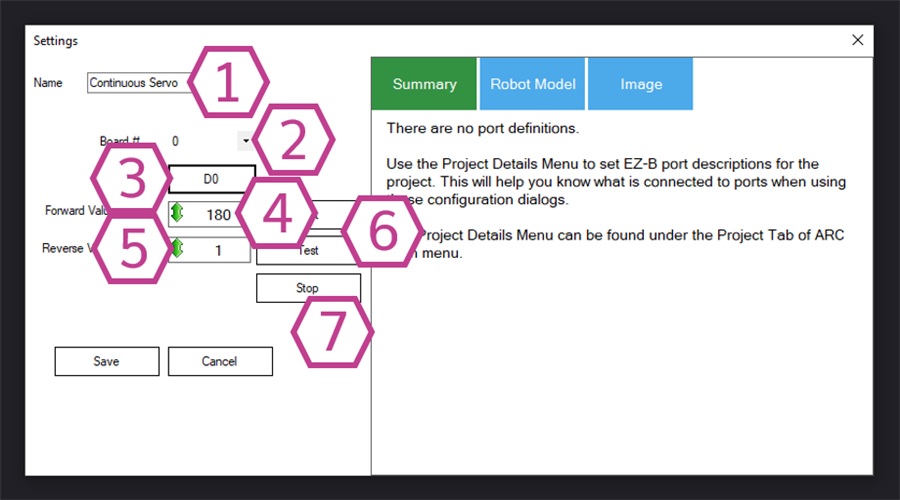
1. Name Field
Enter a name for your continuous servo.
2. Board Index Drop-down
Select the board number that your servo is connected to.
3. Port Drop-down
Select the digital port that your servo is connected to.
4. Forward Value Adjust
Click and hold the left mouse button to adjust the forward value. Right-click to enter it in with the keyboard. The higher the value away from 90°, the faster the servo will spin.
5. Reverse Value Adjust
Click and hold the left mouse button to adjust the reverse value. Right-click to enter it in with the keyboard. The lower the value away from 90°, the faster the servo will spin.
6. Test Buttons
These buttons will allow you to test the Forward and Reverse values while still in the Settings menu.
7. Stop Button
Just as in the main window, pressing the Stop button will release the servo and slow to a stop. If the gearing allows, you should now be able to move the output gear by hand.
How to Use Continuous Servo
1) Add the Continuous Servo skill to your ARC project (Project -> Add Skill -> Servo -> Continuous Servo).
2) Select the digital port that you have a continuous servo plugged into in the skill settings.
3) Adjust the forward and reverse servo values.
4) Press the forward and reverse buttons in the main window to activate the continuous servo.
Video
Requirements
A 3-wire GVS (Ground-Voltage-Signal) 360° Servo Motor.
Resources
Click here for a tutorial on how a servo works.
Click here for a tutorial on using a servo skill.
Related Tutorials
Related Questions
question
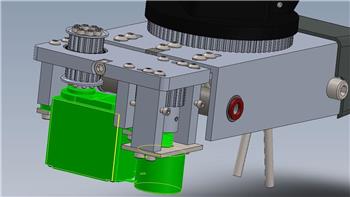
Continuous Servo Control From Variable Resistor.
Good afternoon everyone, Did a search and couldnt find anything on this. My robot has a head that rototes on a 72 tooth...
question
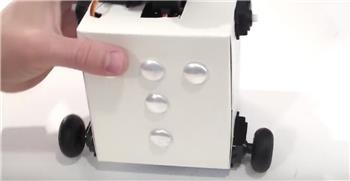
Balancing A Robot On 2 Wheels (EZ Boxbot)
Hi, I saw the EZ Boxbot video done with the EZB V3 and I saw that it balanced with 2 wheels that were flat and and short...
question
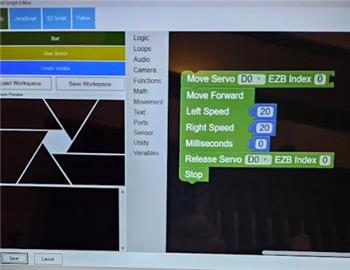
How To Move A Servo 360 Using Blocky With Time
I would like to control a 360-degree continuous rotation servo using Blockly in Synthiam ARC, specifying the duration of...
Upgrade to ARC Pro
ARC Pro is your passport to a world of endless possibilities in robot programming, waiting for you to explore.


